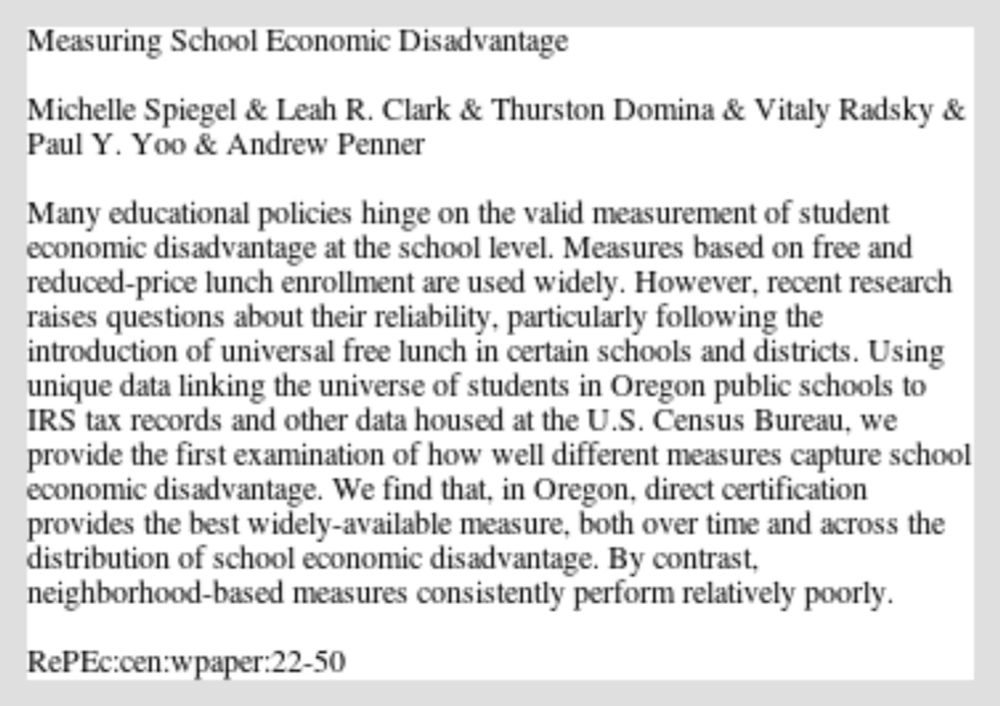
census.gov Notification
Due to the lapse of federal funding, portions of this website are not being updated. Any inquiries submitted via www.census.gov will not be answered until appropriations are enacted.
NEW: The Census Bureau says parts of its website are not being updated because of the federal government shutdown and questions from data users will not be answered "until appropriations are enacted"
01.10.2025 19:20 — 👍 22 🔁 10 💬 1 📌 0
Yeah, honestly: “parental rights” are starting to sound more like “property rights.”
02.09.2025 18:11 — 👍 1009 🔁 126 💬 36 📌 26
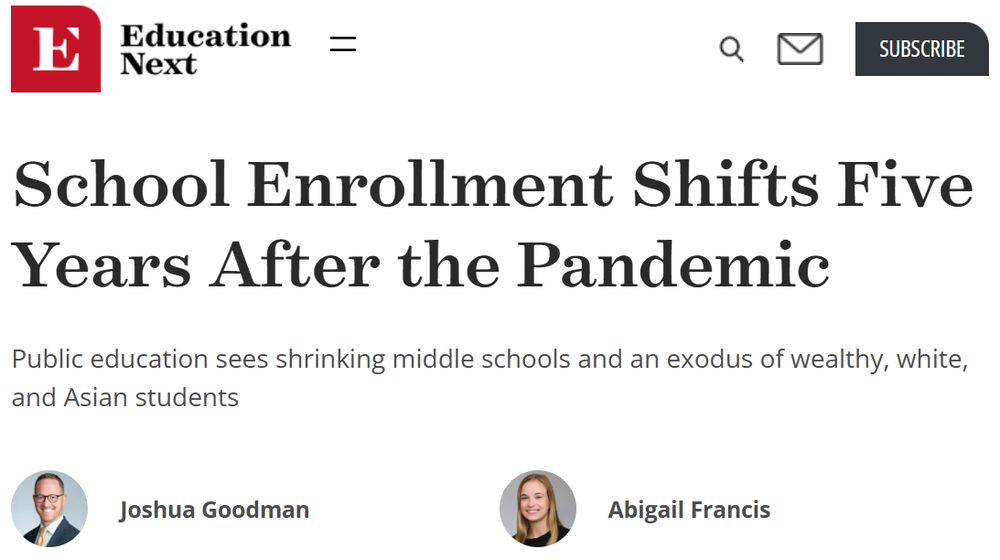
Want to know how the pandemic has reshaped school enrollment patterns in Massachusetts and nationwide?
Here's Education Next's quick and accessible version of our recent working paper:
www.educationnext.org/school-enrol...
@abbyfrancis.bsky.social @educationnext.bsky.social
22.07.2025 13:41 — 👍 15 🔁 5 💬 2 📌 0
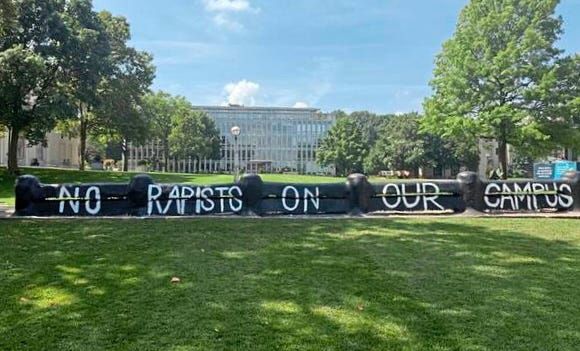
Who is disgracing whom?
There is a Fence located on the central green space of our Carnegie Mellon University campus on which, for more than 100 years, CMU…
Carnegie Mellon University leaders silenced @cmu.edu students who called Trump a rapist claiming they violated civil discourse. I wrote about the disgrace of reprimanding students for rejecting the idea that our campus is a place to engage in civil discourse with rapists. medium.com/@ujuanya/who...
22.07.2025 13:17 — 👍 17 🔁 4 💬 1 📌 0
Unfortunately, direct certification-based measures are not widely available yet. We find no easy solutions to measuring school/student economic disadvantage using publicly-available data, and discuss more in this book chapter: books.google.com/books?hl=en&...
19.06.2025 12:12 — 👍 1 🔁 1 💬 0 📌 0

Trump Wants to Cut More Than 40 Federal K-12 Programs. See Which Ones
The president's detailed budget, released Friday, proposes eliminating dozens of programs as part of a nearly $13 billion cut.
The White House wants to axe funding programs for:
-English learners
-Homeless students
-Migrant students
-Teacher PD
-Civics ed.
-Literacy
-Arts ed.
-Preschoolers with disabilities
-Adult learners
-Rural schools
-School desegregation
-Alaska/Hawaii Native students
www.edweek.org/policy-polit...
05.06.2025 17:40 — 👍 1 🔁 4 💬 0 📌 0

Federal work shaped a Black middle class. Now it's destabilized by Trump's job cuts
For generations of Black workers, federal government jobs have provided a path into the middle class. The Trump administration's workforce cuts are now throwing that sense of stability up in the air.
My latest @npr.org story with Marisa Peñaloza, Kyna Uwaeme and Brent Jones:
For generations of Black workers, federal government jobs have provided a path into the middle class. The Trump administration’s workforce cuts are now throwing that sense of stability up in the air
27.04.2025 10:08 — 👍 269 🔁 80 💬 5 📌 9
Looking for one more paper for the APPAM panel Josh describes here. Please reach out if you have a paper that might fit!
15.04.2025 21:10 — 👍 5 🔁 3 💬 0 📌 0
A couple of us are putting together an APPAM panel on post-pandemic school enrollment/access patterns, broadly conceived.
Let me know if you or someone you know has a paper that might fit this theme.
14.04.2025 14:24 — 👍 9 🔁 7 💬 2 📌 1
CSWEP DC
Submit papers for two CSWEP sponsored sessions at APPAM next fall. Looking especially for papers on health policy and poverty and income policy, broadly interpreted. Deadline extended to April 15. Pls share!
www.aeaweb.org/about-aea/co...
07.04.2025 16:54 — 👍 2 🔁 2 💬 0 📌 0
So, um, some professional news:
25.03.2025 02:54 — 👍 5 🔁 3 💬 1 📌 0
For more technical details, including how we handle students with missing income, check out the online appendix.
Or bug me, @michspieg.bsky.social, @andrewpenner.bsky.social, @emilykpenner.bsky.social, or @t-h-a-d.bsky.social to discuss further!
23.03.2025 23:17 — 👍 5 🔁 0 💬 1 📌 0
We use the Uneven Exposure Index to compare peer income exposure across classroom and school peer groups, and across grade levels. Sorting across schools–-in parallel with income sorting across neighborhoods and towns–-is the driver of the uneven peer income distributions we document.
23.03.2025 23:14 — 👍 0 🔁 0 💬 1 📌 0
Note that an even average distribution is a necessary-–but not sufficient–-condition for truly even peer income exposure. There are schools, especially in urban settings, with high concentrations of poverty. But there are low-income students everywhere, not just in cities.
23.03.2025 23:14 — 👍 0 🔁 0 💬 1 📌 0
The logic behind the Uneven Exposure Index is that if students were evenly distributed by income, they would have 1% of peers in each percentile. We sum up the distance from the even distribution across all 100 percentiles, and divide by 2 to derive Uneven Exposure.
23.03.2025 23:11 — 👍 0 🔁 0 💬 1 📌 0
While more than one-quarter of very high-income peers, on average, would need to be swapped for peers in lower percentiles to achieve an even distribution for very high-income students, students around the 60th income percentile have remarkably even peer income distributions.
23.03.2025 23:10 — 👍 0 🔁 0 💬 1 📌 0
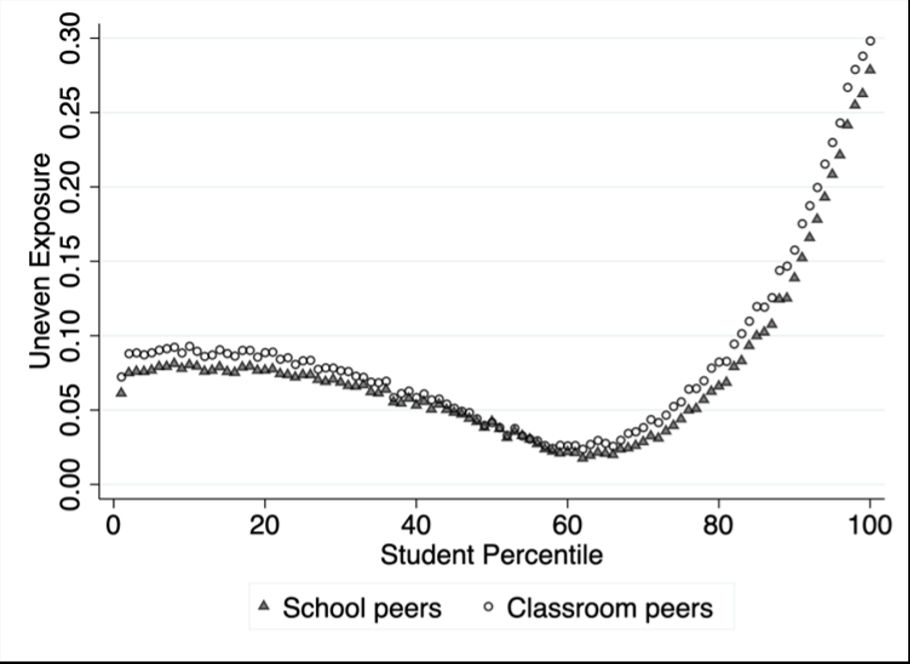
We love the transparency of the basic stats, but for a more succinct summary, we created an Uneven Exposure Index. This is interpreted as the min. proportion of peers, on average, that would have to be swapped with peers in other income percentiles to achieve an even distribution of peer income.
23.03.2025 23:09 — 👍 2 🔁 0 💬 1 📌 0
Allow me to nerd out a bit about the stats in our recent PNAS paper...
To make this graph, we calculated a 100-by-100 grid of the average proportion of peers in each income percentile for students in each percentile (i.e., average peer income distributions for each student percentile). [1/n]
23.03.2025 23:05 — 👍 9 🔁 3 💬 1 📌 0

Economic integration within schools is limited, UC Irvine-led study finds
Economic integration within schools is limited, @ucirvine.bsky.social-led study finds | Research, published in PNAS, highlights disproportionate isolation of students from families in highest income brackets
@uofcalifornia.bsky.social @andrewpenner.bsky.social @stanforduniversity.bsky.social
13.02.2025 17:45 — 👍 4 🔁 4 💬 0 📌 0
How fitting for this new work on economic inequality in schools to come out @pnas.org on the day I learned about Sandy Jencks' death.
His work documenting widening income inequality, segregation in schools, and equality of opportunity is a cornerstone of this study.
14.02.2025 05:16 — 👍 4 🔁 2 💬 1 📌 0

Students in the top 1% of the income distribution are highly isolated in affluent school enclaves.
💥6%💥 of these top 1% percentile kids’ peers are ALSO in the top income percentile.
💥20%💥 are in the top 5 income percentiles.
💥Nearly 50%💥come from the top 20 income percentiles.
14.02.2025 00:25 — 👍 5 🔁 4 💬 1 📌 1
So excited that our new paper, "Peer income exposure across the income distribution," is now out in PNAS!
Great overview (including link to ungated version) from the great @michspieg.bsky.social below.
14.02.2025 00:46 — 👍 3 🔁 0 💬 0 📌 0
Summary thread of working paper: bsky.app/profile/leah...
30.01.2025 00:51 — 👍 1 🔁 0 💬 0 📌 0
Appreciated @marklieberman.bsky.social seeing the relevancy of my study on a choice system that doesn't actually include private school vouchers. Why? Because vouchers are not designed to remedy any of the issues facing public school choice, so will likely produce similar disparities.
30.01.2025 00:50 — 👍 2 🔁 0 💬 1 📌 0
Got so distracted these last few weeks I forgot to look out for this coverage of my new working paper in Ed Week!
30.01.2025 00:46 — 👍 6 🔁 2 💬 1 📌 0
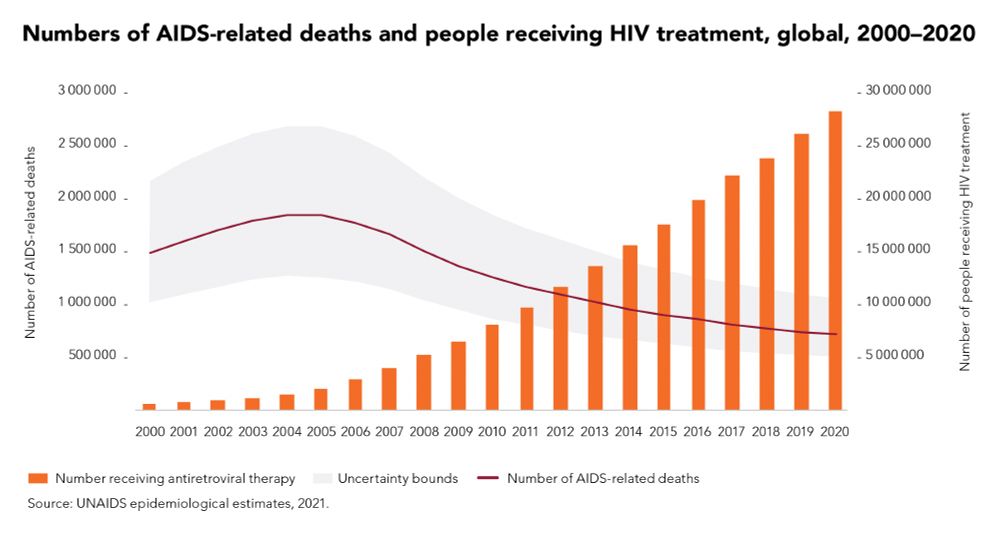
Correlation is not causation, but there's a lot of correlation here. PEPFAR began in 2003 near the peak of world AIDs deaths. Today 20M people receive HIV treatment through PEPFAR funding. That's almost 2/3 of people treated in the world. Call your Congress people and get PEPFAR back.
25.01.2025 14:02 — 👍 96 🔁 43 💬 3 📌 5
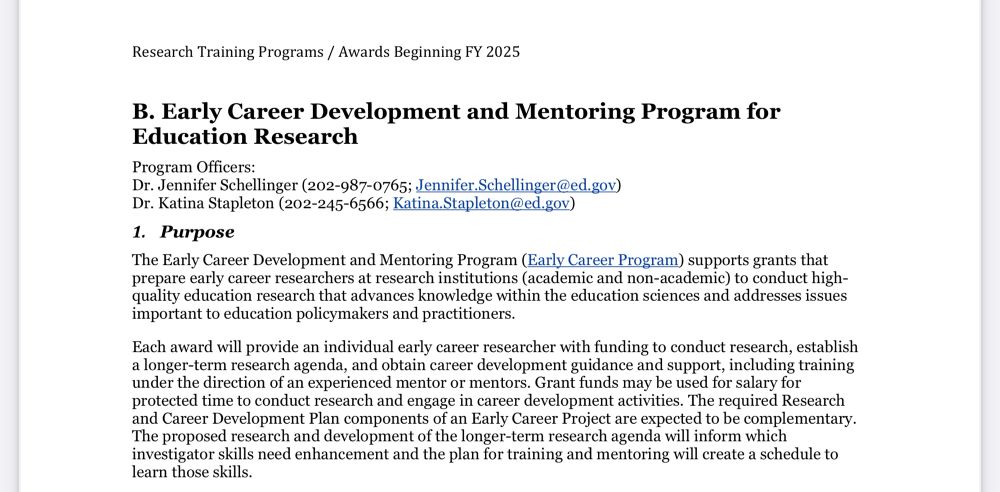
Are you an early career education researcher? Have you earned your PhD since April 1, 2017?
IES has a grant for up to $600K for developing your research, including working closely with a mentor
You need to be tenure track at an R1 or R2
Due March 1
ies.ed.gov/funding/pdf/...
22.01.2025 16:15 — 👍 65 🔁 54 💬 0 📌 2
Social Protection Economist at the OECD. Focussed on working age benefit design.
Economics PhD student at Cornell University. I research economic mobility + [im]migration + record linking w/methods from labor econ, econ history, and econ demography. Road + trail runner
adrianhaws.com
Assistant Professor Universidad Nacional de Colombia. Economist PhD from Rutgers University
https://www.monicamogollonp.com/
A map from https://censusdots.com/ shared daily
PhD student at @ndecon.bsky.social
Working on sovereign debt and international finance.
❤️📊 | 🗣️DE|EN|FR | #rstats | #econsky
Sociologist @Erasmus University Rotterdam
Social security, families, inequalities
https://sites.google.com/view/marigabriele/home
Colombian. Education PhD Candidate at University of California, Irvine. || Early childhood, community violence, stress, quantitative methods
Co-creating and integrating evidence in practice to improve PK-20+ learning for individuals, systems, and society. Identities blend HS STEM teacher, university faculty, district administrator, cognitive scientist, education researcher. Views my own.
Demographer | Associate Professor of Sociology at Texas A&M University | Associate Director of @TxRDC | President of @sda-demography | Demography, mortality, health disparities
Senior editor @ucpress.bsky.social. Finicky reader. (She/her)
phd candidate at Stanford | researching role of place, parenting, and policy in shaping early childhood opportunities | firstgen 🇦🇷🇺🇸
UMD 2026 / US Census Bureau
Macroeconomics and Spatial Economics
▫️writing about ed policy and politics
▫️former middle & high school teacher (13 years 🇺🇲 & 🇧🇷)
▫️PhD in international ed policy
▫️posts are mine & reposts mean "hey look at this”
https://campsite.to/stephmhall
Professor of Economics at UC San Diego
Director of CEPA: https://cepa.ucsd.edu/
Adjunct Senior Fellow at the Hoover Institution
Research Associate at NBER
Editorial Boards at JPUBEC, JHE, JEP, and AEJ: Policy
Association for Education Finance and Policy (AEFP), a non-profit academic and professional organization.
Research Assistant Professor at @umichstonecid.bsky.social, working on topics related to housing, wealth, and inequality.
Director, @stanforddel.bsky.social
Professor Stanford Institute for Human-centered AI, SIEPR, Stanford department of Economics and GSB
Author https://amazon.com/Second-Machine-Age-Prosperity-Technologies/dp/0393350649
Education policy researcher and professor at Wayne State University, DPSCD parent, neighbor, friend. Director of Detroit PEER: detroitpeer.org



